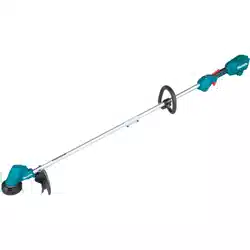Loading ...
Loading ...

3 ENGLISH
7. The string trimmer should be switched o
immediately if it shows any signs of abnormal
operation.
8. Don't force the tool. It will do the job better and
with less likelihood of a risk of injury at the rate for
which it was designed.
9. Don't overreach. Keep proper footing and
balance at all times.
10. Stay Alert - Watch what you are doing. Use
common sense. Do not operate appliance
when you are tired.
11. Store idle appliances indoors.
12. Keep ngers away from switch trigger when
not operating the tool and when moving from
one operating position to another.
Intended use of the tool
1. Use right tool. The cordless string trimmer
is only intended for cutting grass and light
weeds. It should not be used for any other
purpose such as edging or hedge cutting as
this may cause injury.
2. Use only the manufacturer’s recommended
accessories and attachments. Use of any other
accessories and attachments may increase the
risk of injury.
Personal protective equipment
1. Dress Properly. The clothing worn should be
functional and appropriate, i.e. it should be
tight-tting but not cause hindrance. Do not
wear loose clothing or jewelry. They can be
caught in moving parts. Wear protective hair
covering to contain long hair.
2. In order to avoid either head, eye, hand or foot
injuries as well as to protect your hearing the
following protective equipment and protective
clothing must be used during operation of the
equipment.
3. Use safety glasses. Protective goggles pro-
tect your eyes from ying debris and stones.
During operation of the tool always wear gog-
gles to prevent eye injuries.
4. Wear adequate noise protection equipment
to avoid hearing impairment (ear mus , ear
plugs etc.).
5. Work overalls protect against injury from
ying stones and debris. It is strongly recom-
mended that the user wears work overalls.
6. Use a dust mask if operation is dusty.
Electrical and battery safety
1. Avoid dangerous environment. Don't use the
tool in damp or wet locations or expose it to
rain. Water entering the tool will increase the risk
of electric shock.
2.
Prevent unintentional starting. Ensure the switch
is in the o-position before connecting to battery
pack, picking up or carrying the machine. Carrying
the machine with your nger on the switch or energiz-
ing machine that have the switch on invites accidents.
3. Disconnect the battery pack from the machine
before making any adjustments, changing
accessories, or storing machine. Such preven-
tive safety measures reduce the risk of starting the
machine accidentally.
4. Recharge only with the charger specied by
the manufacturer. A charger that is suitable for
one type of battery pack may create a risk of re
when used with another battery pack.
5. Use machines only with specically desig-
nated battery packs. Use of any other battery
packs may create a risk of injury and re.
6. When battery pack is not in use, keep it away
from other metal objects, like paper clips,
coins, keys, nails, screws or other small metal
objects, that can make a connection from one
terminal to another. Shorting the battery termi-
nals together may cause burns or a re.
7.
Under abusive conditions, liquid may be ejected
from the battery; avoid contact. If contact acci-
dentally occurs, ush with water. If liquid con-
tacts eyes, seek medical help. Liquid ejected from
the battery may cause irritation or burns.
8. Do not use a battery pack or machine that is
damaged or modied. Damaged or modied
batteries may exhibit unpredictable behaviour
resulting in re, explosion or risk of injury.
9.
Do not expose a battery pack or machine to re or
excessive temperature. Exposure to re or tem-
perature above 130°C (265°F) may cause explosion.
10. Follow all charging instructions and do not
charge the battery pack or machine outside of
the temperature range specied in the instruc-
tions. Charging improperly or at temperatures
outside of the specied range may damage the
battery and increase the risk of re.
Loading ...
Loading ...
Loading ...
